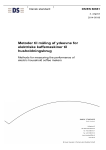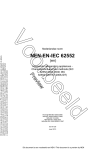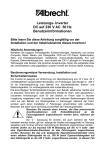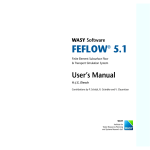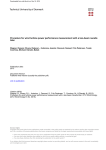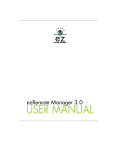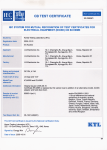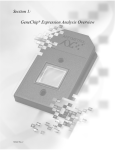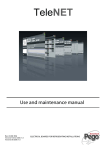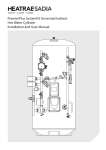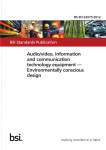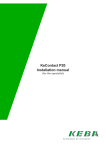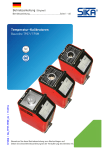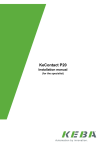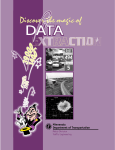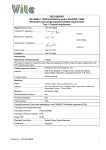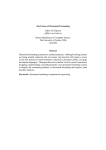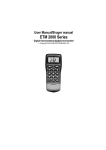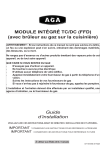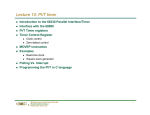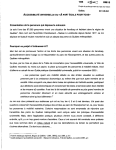Download EN 62552 - Dansk Standard
Transcript
Dansk standard DS/EN 62552 1. udgave COPYRIGHT © Danish Standards Foundation. NOT FOR COMMERCIAL USE OR REPRODUCTION. DS/EN 62552:2013 2013-05-03 Køleapparater til husholdningsbrug – Karakteristika og prøvningsmetoder Household refrigerating appliances – Characteristics and test methods DS/EN 62552 København DS projekt: M254892 ICS: 97.030 COPYRIGHT © Danish Standards Foundation. NOT FOR COMMERCIAL USE OR REPRODUCTION. DS/EN 62552:2013 Første del af denne publikations betegnelse er: DS/EN, hvilket betyder, at det er en europæisk standard, der har status som dansk standard. Denne publikations overensstemmelse er: MOD med: IEC 62552 ED 1.0:2007. IDT med: EN 62552:2013. DS-publikationen er på engelsk. Denne publikation erstatter: DS/EN ISO 15502:2005, DS/EN ISO 15502/AC:2007 og DS/EN 153:2006. DS-publikationstyper Dansk Standard udgiver forskellige publikationstyper. Typen på denne publikation fremgår af forsiden. Der kan være tale om: Dansk standard • standard, der er udarbejdet på nationalt niveau, eller som er baseret på et andet lands nationale standard, eller • standard, der er udarbejdet på internationalt og/eller europæisk niveau, og som har fået status som dansk standard DS-information • publikation, der er udarbejdet på nationalt niveau, og som ikke har opnået status som standard, eller • publikation, der er udarbejdet på internationalt og/eller europæisk niveau, og som ikke har fået status som standard, fx en teknisk rapport, eller • europæisk præstandard DS-håndbog • samling af standarder, eventuelt suppleret med informativt materiale DS-hæfte • publikation med informativt materiale Til disse publikationstyper kan endvidere udgives • tillæg og rettelsesblade DS-publikationsform Publikationstyperne udgives i forskellig form som henholdsvis • fuldtekstpublikation (publikationen er trykt i sin helhed) • godkendelsesblad (publikationen leveres i kopi med et trykt DS-omslag) • elektronisk (publikationen leveres på et elektronisk medie) DS-betegnelse Alle DS-publikationers betegnelse begynder med DS efterfulgt af et eller flere præfikser og et nr., fx DS 383, DS/EN 5414 osv. Hvis der efter nr. er angivet et A eller Cor, betyder det, enten at det er et tillæg eller et rettelsesblad til hovedstandarden, eller at det er indført i hovedstandarden. DS-betegnelse angives på forsiden. Overensstemmelse med anden publikation: Overensstemmelse kan enten være IDT, EQV, NEQ eller MOD • IDT: Når publikationen er identisk med en given publikation. • EQV: Når publikationen teknisk er i overensstemmelse med en given publikation, men præsentationen er ændret. • NEQ: Når publikationen teknisk eller præsentationsmæssigt ikke er i overensstemmelse med en given standard, men udarbejdet på baggrund af denne. • MOD: Når publikationen er modificeret i forhold til en given publikation. EN 62552 EUROPEAN STANDARD NORME EUROPÉENNE EUROPÄISCHE NORM March 2013 COPYRIGHT © Danish Standards Foundation. NOT FOR COMMERCIAL USE OR REPRODUCTION. DS/EN 62552:2013 ICS 97.030 Supersedes EN 153:2006, EN ISO 15502:2005 + corr. Dec.2007 English version Household refrigerating appliances Characteristics and test methods (IEC 62552:2007, modified + corrigendum Mar. 2008) Appareils de réfrigération à usage ménager Caractéristiques et méthodes d'essai (CEI 62552:2007, modifiée + corrigendum Mar. 2008) Haushalt-Kühl-/Gefriergeräte Eigenschaften und Prüfverfahren (IEC 62552:2007, modifiziert + corrigendum Mar. 2008) This European Standard was approved by CENELEC on 2012-10-22. CENELEC members are bound to comply with the CEN/CENELEC Internal Regulations which stipulate the conditions for giving this European Standard the status of a national standard without any alteration. Up-to-date lists and bibliographical references concerning such national standards may be obtained on application to the CEN-CENELEC Management Centre or to any CENELEC member. This European Standard exists in three official versions (English, French, German). A version in any other language made by translation under the responsibility of a CENELEC member into its own language and notified to the CEN-CENELEC Management Centre has the same status as the official versions. CENELEC members are the national electrotechnical committees of Austria, Belgium, Bulgaria, Croatia, Cyprus, the Czech Republic, Denmark, Estonia, Finland, Former Yugoslav Republic of Macedonia, France, Germany, Greece, Hungary, Iceland, Ireland, Italy, Latvia, Lithuania, Luxembourg, Malta, the Netherlands, Norway, Poland, Portugal, Romania, Slovakia, Slovenia, Spain, Sweden, Switzerland, Turkey and the United Kingdom. CENELEC European Committee for Electrotechnical Standardization Comité Européen de Normalisation Electrotechnique Europäisches Komitee für Elektrotechnische Normung Management Centre: Avenue Marnix 17, B - 1000 Brussels © 2013 CENELEC - All rights of exploitation in any form and by any means reserved worldwide for CENELEC members. Ref. No. EN 62552:2013 E EN 62552:2013 –2– COPYRIGHT © Danish Standards Foundation. NOT FOR COMMERCIAL USE OR REPRODUCTION. DS/EN 62552:2013 Foreword This document (EN 62552:2013) consists of the text of IEC 62552:2007 + corrigendum 2008 prepared by IEC/TC 59 "Performance of household and similar electrical appliances", together with the common modifications prepared by CLC/TC 59X "Performance of household and similar electrical appliances". The following dates are fixed: • • latest date by which this document has to be implemented at national level by publication of an identical national standard or by endorsement latest date by which the national standards conflicting with this document have to be withdrawn (dop) 2013-10-22 (dow) 2015-10-22 This document supersedes EN 153:2006 and EN ISO 15502:2005 + AC:2007. EN 62552:2013 includes the following significant technical changes with respect to EN 153:2006 and EN ISO 15502:2005: – new compartment: zero star; – new compartment: wine storage, combined with requirements for vibration, temperature fluctuation and humidity; – new compartment: pantry; – new compartment: multi-use; – new compartment: through-the-door-devices; – requirements for circumvention. EN ISO 15502:2005 + AC:2007, Household refrigerating appliances – Characteristics and test methods, is based on ISO 15502:2005 and its corrigendum Cor 1:2007; this International Standard, prepared by subcommittee 5: Testing and rating of household refrigeration appliances of ISO technical committee 86, Refrigeration and air-conditioning, was transferred to the IEC subsequent to IEC SMB decision 127/11. ISO 15502:2005 and its corrigendum are superseded by IEC 62552:2007. EN 153:2006, Methods of measuring the energy consumption of electric mains operated household refrigerators, frozen food storage cabinets, food freezers and their combinations, together with associated characteristics, was prepared by CEN/TC 44, Household refrigerating appliances and commercial refrigeration equipment. Clauses, subclauses, notes, tables, figures and annexes which are additional to those in IEC 62552:2007 are prefixed “Z”. Attention is drawn to the possibility that some of the elements of this document may be the subject of patent rights. CENELEC [and/or CEN] shall not be held responsible for identifying any or all such patent rights. This document has been prepared under a mandate given to CENELEC by the European Commission and the European Free Trade Association. –3– EN 62552:2013 COPYRIGHT © Danish Standards Foundation. NOT FOR COMMERCIAL USE OR REPRODUCTION. DS/EN 62552:2013 Endorsement notice The text of the International Standard IEC 62552:2007 + corrigendum 2008 was approved by CENELEC as a European Standard with the following common modifications. COMMON MODIFICATIONS 2 Normative references Delete the reference to ISO 817. Delete the reference to IEC 60335-2-24:2002 3 Terms, definitions and symbols Add the following definitions after 3.1.7: 3.1.Z1 wine storage appliance refrigerating appliance having one or more and only compartments exclusively designed for storage of wine Note 1 to entry: An appliance containing compartment(s) which does not fulfil all requirements as specified for wine storage compartments cannot be called wine storage appliance. 3.1.Z2 multi door or other appliances refrigerating appliance having two or more compartments, each one specified according to one of specifications as to Table 2 and being not covered by definitions as to 3.1.1 till 3.1.Z1 3.1.Z3 thermoelectric refrigerating appliance refrigerating appliance where the cooling uses the Peltier effect 3.1.Z4 Mobile refrigerating appliance appliance that is primarily intended to be used at different locations, having a mass of less than 18 kg Note 1 to entry: While being moved, the appliance does not necessarily need to be operating. Add the following definitions after 3.3.3: 3.3.Z1 zero-star compartment low-temperature compartment intended for the freezing and storage of ice and for short time storage of frozen food in which the temperature is not warmer than 0 °C EN 62552:2013 –4– 3.3.5.Z2 wine storage compartment compartment exclusively designed either for short-term wine storage to bring wine to the ideal drinking temperature or for long-term storage of wine, with the following features: COPYRIGHT © Danish Standards Foundation. NOT FOR COMMERCIAL USE OR REPRODUCTION. DS/EN 62552:2013 – a storage temperature range, either pre-set or set manually according to the manufacturer’s instructions, in the range from +5 °C to +20 °C, each compartment providing twma ≤ +12 °C; Note 1 to entry: The range from +5 °C to +20 °C indicates the maximum allowed range, no target values. If there is more than one wine storage compartment in one appliance, the temperature setting range can also be subdivided covering only part of the temperature range by each wine storage compartment. – measured storage temperature(s) within a variation over time of less than 0,5 K at each declared ambient temperature specified by the climate class for household refrigerating appliances (see 8.Z1); – active or passive control of the compartment humidity within a range from 50 % to 80 % relative humidity; – constructed to reduce the transmission of vibration to the compartment, whether from the refrigerator compressor or from any external source 3.3.5.Z3 pantry compartment compartment intended for the storage of particular foods or beverages at a temperature warmer than that of the cellar compartment 3.3.5.Z4 multi-use-compartment compartment intended for use at two or more of the temperatures of the compartment types in Table 2, capable of being set by the user to remain at the operating temperature range applicable to each compartment type Note 1 to entry: Where temperatures can shift to a different operating range for a period of limited duration only, the compartment is not a "multi-use compartment". 3.3.5.Z5 low ambient switch device activated at the low ambient temperatures, automatically or manually, to balance the temperatures in different compartment types used in combination if applicable 3.3.5.Z6 thermal accumulator device with thermal capacity provided by manufacturer Replace Definitions 3.5.3, 3.5.4, 3.5.5 and 3.5.6 by: 3.5.3 overall dimensions space – height, width and depth – with doors or lids closed 3.5.4 overall space required in use total space – height, width and depth – with doors or lids open 3.5.5 gross volume volume within the inside liner of the refrigerating appliance or of a compartment with an external door, in every case without internal fittings and with doors or lids closed –5– EN 62552:2013 COPYRIGHT © Danish Standards Foundation. NOT FOR COMMERCIAL USE OR REPRODUCTION. DS/EN 62552:2013 3.5.6 storage volume part of the gross volume of any compartment that remains after deduction of the volume of components and spaces unusable for the storage of food Note 1 to entry: See 7.2. In Definition 3.5.7, delete the note. Add the following definitions after 3.6.23: 3.6.Z1 wine compartment storage temperature twma mean temperature of the wine storage compartment 3.6.Z2 humidity wine compartment RHwim internal relative humidity in a wine storage compartment as integrated time average 3.6.Z3 pantry compartment storage temperature tpma mean temperature of the pantry storage compartment Add the following definitions after 3.7.4: 3.7.Z1 humidity control device device which automatically regulates the humidity level inside a compartment 3.7.Z2 ambient air exchange device device which allows to exchange the air in a refrigerating compartment with ambient air, either fix as to manufacturer design, or to be controlled automatically, or to be set manually by the user as to manufacturer's instructions Note 1 to entry: 3.8 The hole for defrosting water draining is not considered as an air exchange device. Symbols Replace the content by: Ti, Tci ,Twi ,Tai temperature measurement positions ti instantaneous temperature value (fresh food compartment) ( ) t * , t*, t**, t*** The temperatures of each compartment, cabinet or section is the maximum temperature of any M-package in that compartment, cabinet or section. tamb1, tamb2 instantaneous ambient temperature value tamb1.m / tamb2.m integrated time average of tamb1/tamb2 tamb.ma arithmetic average of tamb1.m and tamb2.m tci instantaneous temperature value (cellar compartment) COPYRIGHT © Danish Standards Foundation. NOT FOR COMMERCIAL USE OR REPRODUCTION. DS/EN 62552:2013 EN 62552:2013 –6– tcc instantaneous temperature value (chill compartment) twi instantaneous temperature value (wine storage compartment) tpi instantaneous temperature value (pantry compartment) tim integrated time average of ti tcim integrated time average of tci twvim integrated time average of twi tpvim integrated time average of tpi tva instantaneous arithmetic average of t1, t2, t3 tca instantaneous arithmetic average of tc1, tc2, tc3 tma arithmetic average of t1m, t2m, t3m tcma arithmetic average of tc1m, tc2m, tc3m twma arithmetic average of tw1m, tw2m, tw3m tpma arithmetic average of tp1m, tp2m, tp3m RHwi instantaneous relative humidity (wine storage compartment) RHwim integrated time average of RHwi E24h energy consumption of household refrigerating appliance in kWh/24 h (conditions as in Table 5) i subscript representing 1, 2 or 3 4 Classification Add the following text after Table 1: If the lowest declared temperature is not within standard climate classes, the lowest ambient temperature is the temperature where the appliance can be used fulfilling the storage test requirements. This temperature shall be indicated in the user manual and the test report. 5 Materials, design and manufacture Add the following after 5.7.6: 5.7.Z1 Wine storage appliances and wine storage compartments shall be constructed by using suitable means to reduce transmission of vibration to the compartment(s), whether from the refrigerating system or from any external source. COPYRIGHT © Danish Standards Foundation. NOT FOR COMMERCIAL USE OR REPRODUCTION. DS/EN 62552:2013 –7– 6 EN 62552:2013 Storage temperatures Replace Table 2 by the following table: Table 2 – Storage temperatures °C Fresh-food storage compartment t1m, t2m, t3m tma 0 ≤ t1m, t2m, t3m ≤ 8 ≤ +4 Food freezer and three-star compartment/ cabinet Two-star compartment/ section One-star compartment Cellar compartment Chill compartment t*** t** t* tcm tcc ≤ -6 +8 ≤ tcm ≤ +14 -2 ≤ tcc ≤ +3 ≤ -18 a ≤ -12 a Wine compartment twma a, b +5 ≤ twma ≤ +20 twma ≤ +12 Zero-star compartment Pantry compartment ( ) tpma t* ( ) t* ≤0 +14 < tpma < +20 a As a result of a defrost cycle, the storage temperatures of frost free and/or adaptive defrost refrigerating appliances are permitted to rise by no more than 3 K during a period not greater than 4 h or 20 % of the duration of the operating cycle, whichever is the shorter. An example of an operating cycle for a frost-free refrigerator-freezer is given in Figure 1. For wine storage compartments applies that the maximum temperature twi shall not be more than 1,5 K above integrated time average temperature twim for each measuring point. b The range +5 °C to +20 °C indicates the maximum allowed range, no target values. If there are more than one wine storage compartment in one appliance the temperature setting range can also be subdivided covering only part of the temperature range by each wine storage compartment. Each compartment shall provide twma ≤ +12 °C. EN 62552:2013 –8– 7 Determination of linear dimensions, volumes and areas 7.1 Determination of linear dimensions st nd COPYRIGHT © Danish Standards Foundation. NOT FOR COMMERCIAL USE OR REPRODUCTION. DS/EN 62552:2013 Change 1 sentence of 2 paragraph to: The measurement shall be carried out on the refrigerating appliance in its final condition for use (i.e. all external fittings supplied with the appliance for installation by the user). rd Add sentence to 3 paragraph: If there is a difference between the delivery status and the final condition for use this information shall be made available to the user at the point of sale. Figure 2: Change drawing to include space for air circulation mentioned in paragraph 4 Replace title and text of 7.2.4 by: 7.2.4 Storage volume of fresh-food storage, chill, cellar, pantry and wine storage compartments The storage volume of the fresh-food storage, chill, cellar, pantry and wine storage compartment shall be the gross volume of the compartment minus – the volume of the evaporator space, – the volume of any housings (such as those for interior lights, temperature-control devices and other devices e.g. non removable telescopic guides), – the volume of shelves, partitions, retainers and other accessories whose wall thickness is greater than 13 mm according to 7.2.9.1, – the space between the inner door protrusion and the inner liner of the fresh-food storage compartment, chill, cellar pantry and wine storage compartment, unless it is intended for the storage of food. Where the volumes of the cellar compartment, pantry and wine storage compartment and fresh-food storage compartment are adjustable relative to one another by the user, the storage volumes of these –9– EN 62552:2013 compartments shall be determined with the cellar compartment, pantry or/and wine storage compartment adjusted to its minimum and maximum volumes. COPYRIGHT © Danish Standards Foundation. NOT FOR COMMERCIAL USE OR REPRODUCTION. DS/EN 62552:2013 Add the following sentence at the end of 7.2.5.2: Where the evaporator is covered by fix means, the depth of the evaporator space shall be taken as the mean horizontal distance to the foremost part of the protection cover. Replace the text of 7.2.5.3 by: The width of the evaporator space shall be the overall horizontal width of the evaporator itself or the protection or cover where applicable (neglecting suction headers near the top of the evaporator) or, if side ribs are used, the overall width including the ribs. If there is less than 70 mm horizontal distance between the evaporator or the ribs or the protection or cover where applicable and an inside wall of the enclosed space of the cabinet, such space shall be considered as part of the evaporator space. Replace the text of 7.2.5.4 by: The height of the evaporator space shall be the mean vertical distance between the lower limit of the evaporator or the protection or cover where applicable and the upper partition of the food storage compartment. If the free space between the upper surface or top of the evaporator or the protection or cover where applicable and the upper partition of the food storage compartment exceeds 40 mm, it shall be added to the storage volume of the fresh-food storage compartment. The evaporator height shall include any internal drip tray and/or drip collector, except in the case when the storage height of the drip tray is greater than 40 mm and a definite manual operation is also needed to initiate defrosting. Replace title and text of 7.3.2.7.2 by: 7.3.2.7.2 Fresh-food storage compartment, chill, cellar pantry and wine storage compartments Any part of a full shelf, basket or the bottom of a compartment having less than 100 mm vertical clearance above, when all the shelves and baskets are in position, shall be excluded when calculating the storage area. However, it is admissible that for one full shelf or basket the vertical clearance may be reduced to not less than 80 mm (see Figure 19 b)). For specific shelves as bottles shelves used in e.g. wine storage compartments, no vertical clearance requirement applies. Replace title and text of 7.3.4.1 by: 7.3.4.1 Fresh-food storage compartment, chill, cellar and wine storage compartments The area of the interior surface of the bottom of a suspended container and the area of the shelf immediately below shall not both be counted, unless the vertical clearance between this shelf and the exterior surface of the bottom of the container is at least 100 mm. For specific shelves as bottles shelves used in e.g. wine storage compartments, no vertical clearance requirement applies. Nevertheless, in the case of one container – and one only – this minimum clearance may be reduced to 80 mm to the extent where this possibility has not been applied for the shelves. EN 62552:2013 – 10 – If the minimum vertical clearance within a suspended container, as measured between the interior surface of the bottom and the cover, or to the shelf immediately above, is less than 40 mm, the bottom area of the container shall not be added. COPYRIGHT © Danish Standards Foundation. NOT FOR COMMERCIAL USE OR REPRODUCTION. DS/EN 62552:2013 Add the following new subclause after 7.3.4.2: 7.3.4.Z1 Evaluation of bottle capacity for wine storage compartments For the evaluation of the rated capacity of bottles 0,75 l bottles or equivalent substitution with dimension as specified in Figure Z1 shall be used. Bottles to be filled with water to provide a total weight of each bottle of 1 200 g ± 50 g to consider the deformation of shelves. Removable parts which are stated by the manufacturer as necessary for the proper thermal and mechanical functioning of the wine storage compartment have to be placed in its intended position as to manufacturer's instructions. Bottles will be stacked on each area intended to carry bottles in normal usage as to following rules: – clearance to wall/back/door as to manufacturer's instructions; – in the absence of instructions the rear end of shelves and 5 mm clearance to door are considered as limit, proper cooling function has to be ensured; – bottles placed in door shelves may touch door liner; – if evaporator is covered by fix means for protection bottles can stack till the protection, proper cooling function has to be ensured; – bottles can be placed reverse and interleave; – bottles can be in touch with side walls if nothing else stated by manufacturer; – bottles can be placed horizontal or vertical, inclined if fixed means provide incline position; – movable parts like telescopic shelves have to be kept movable and accessible under loading conditions. A sketch of the bottle loading plan showing the location of bottles for evaluation of the bottle capacity for wine storage compartments shall be included in test report. 8 General test conditions 8.2 Ambient temperatures Replace the text by: Local ambient temperatures tamb1 and tamb2 are measured at two points Ta1 and Ta2, located at the vertical and horizontal centreline of the sides of the refrigerating appliance and at a distance of 350 mm from the refrigerating appliance (see Figure 3). The overall ambient temperature tamb.ma for a single appliance is the arithmetical average of the timeintegrated temperatures tamb1.m and tamb2.m. It is the value used for the tests. Ambient temperatures are measured using copper or brass cylinders (see 8.7) at each of the two measurement points. Ambient temperature sensors shall be shielded from any sources or sinks of radiant and or convective heat in the test room, including conditioning equipment, external windows, the appliance itself or other appliances under test. – 11 – EN 62552:2013 During all tests the integrated time average temperatures tamb1.m and tamb2.m shall be within ± 0,5 K from the arithmetic average ambient temperature tamb.ma. The vertical ambient temperature gradient from the platform specified in 8.4 to a height of 2 m shall not exceed 1 K/m measured at the same vertical axis as for the ambient temperature measurement. COPYRIGHT © Danish Standards Foundation. NOT FOR COMMERCIAL USE OR REPRODUCTION. DS/EN 62552:2013 Tests shall be carried out under the following conditions of measured ambient temperature. a) For checking the storage temperatures: + 10 °C and + 32 °C for class SN refrigerating appliances; + 16 °C and + 32 °C for class N refrigerating appliances; + 16 °C and + 38 °C for class ST refrigerating appliances; + 16 °C and + 43 °C for class T refrigerating appliances. For a rated range of climate classes, tests shall be performed at the extreme ambient temperatures of the range of rated classes. EXAMPLE For refrigerating appliances rated from SN to T, tests are performed at + 10 °C and at + 43 °C. b) For checking the energy consumption, temperature rise time, freezing capacity and ice-making capacity of all refrigerating appliances, as applicable: + 25 °C c) for class SN, class N, class ST and class T refrigerating appliances. For all other tests: at the temperature stated in the test specifications. 8.3 Humidity Replace the text by: Unless otherwise specified, relative humidity shall not exceed 75 %. For the test measuring of humidity in wine storage compartments, the relative ambient humidity shall be 50 % ≤ RH ≤ 75 % (see 8.Z2). 8.4 Installation of refrigerating appliances Replace a) by: a) One of the partitions shall be placed parallel to the rear of the refrigerating appliance: 1) for free-standing appliances, against the spacers defined as physically existing devices which fix the distance between the rear of the appliance and the wall behind the appliance. They can either be permanently attached to the appliance or provided as separate parts, which have to be installed by the user. If no spacers are provided then the manufacturer specification for the rear clearance shall be observed: The rear clearance is defined as the distance between the rear side of the appliance (rearmost projection) and the vertical partition. The rear side of the appliance is defined as the back wall of the foam housing itself, so excluding any condenser or other protruding elements. Where the rear clearance is specified, the appliance shall be positioned such that this clearance is respected with a maximum of 50 mm. EN 62552:2013 – 12 – Where the rear clearance is not specified, the appliance is to be positioned with its rearmost projection in contact with the vertical surface behind it. COPYRIGHT © Danish Standards Foundation. NOT FOR COMMERCIAL USE OR REPRODUCTION. DS/EN 62552:2013 For free-standing absorber appliances the manufacturer specification for the rear clearance shall be observed (without spacer maximum 20 mm between rearmost projection and wall). 2) for built-in appliances, at the distance specified by the manufacturer in connection with the required overall space. 3) for mobile appliances, at the distance specified by the manufacturer The consumer shall be informed about the influence of this condition on the measure of the energy consumption of the appliance. Add the following note after a): NOTE Stops are physically existing devices which fix the distance between the rear of the appliance and the wall behind the appliance. They can either be permanently attached to the appliance or provided as separate parts, which are installed by the user. 8.5 Test packages In 8.5.2, replace the last sentence of b) by: For the measurement of chill compartments and zero-star compartment, only test package b), with a freezing point of -5 °C, shall be used. 8.6 Operating requirements for refrigerating appliances At the end of 8.6.3.1, add the following sentence: Where the refrigerating appliance has a rated voltage within the range between 220 V and 240 V, it shall be tested at 230 V ± 1 % with a frequency of 50 Hz ± 1 %. At the end of 8.6.4, add the following sentences: If position of shelves is adjustable, those shall be spread equally in the cabinet. For wine storage compartments shelves, baskets and container shall be in position as defined in 7.3.4.Z1. Replace the text of 8.6.5 by: Accessories that are not necessary for the normal operation of the refrigerating appliance shall remain non-operational during testing, as long as nothing specific is specified in any other paragraph. Add the following new subclause after 8.6.5: 8.6.Z1 Through-the-door devices If the refrigerating appliance is fitted with a through the door device this shall be closed. Every energy consuming additional device (e.g. display, lightening etc.) is to be switched on when starting the test. Operation like ice or water dispensing will not be performed. – 13 – EN 62552:2013 8.7 Measuring instruments th In 8.7.1, replace the 5 paragraph by: COPYRIGHT © Danish Standards Foundation. NOT FOR COMMERCIAL USE OR REPRODUCTION. DS/EN 62552:2013 Temperature-measuring instruments shall have an overall accuracy of measurement of not greater than ± 0,3 K. This accuracy shall be maintained throughout the temperature measuring circuit. Regular calibration of temperature equipment is required at the temperature range of interest. Replace the text of 8.7.2 by: The relative humidity shall be measured and recorded at a point which is representative. The accuracy of the measuring instruments shall be such that the result, expressed as the dew point, shall have an overall accuracy of measurement of not greater than ± 0,3 K. Replace the text of 8.7.3 by: Watt-hour meters shall be readable to 0,001 kW h and be accurate to within ± 1 % of the total energy consumption measured during the test period (i.e. 1 % of reading). Calibration of Watt-hour meters shall be performed at the range used in the measurements. The measuring accuracy shall be stated in the test report. 8.8 Measurement of storage temperature Replace the title and text of 8.8.1 by: 8.8.1 Fresh-food storage compartment, cellar compartment and pantry compartment The temperatures t1m, t2m and t3m (see 3.6.2 and 3.8), tc1m, tc2m, tc3m (see 3.6.4 and 3.8) and tp1m, tp2m, tp3m (see 3.6.Z3 and 3.8) shall be measured using copper or brass cylinders, except for the freezing test of refrigerator-freezers, when they shall be measured in M-packages suspended and located at the temperature-sensing points. For determining the storage temperature, the temperature-sensing points shall be located at T1, T2, T3, Tc1, Tc2, Tc3, and Tp1, Tp2, Tp3 as shown in Figures 14 and 15, halfway between the rear internal wall of the appliance and the internal wall of the closed door. The temperatures t1m, t2m and t3m, and tc1m, tc2m and tc3m and tp1m, tp2m and tp3m at the temperature-sensing points shall be the integrated time averages of t1, t2 and t3, and tc1, tc2 and tc3, and tp1, tp2 and tp3 respectively, during an test period with an integral step of 60 s or less. The storage temperatures tma (see 3.6.2), tcma (see 3.6.4) and tpma (see 3.6.Z3) are the arithmetical average of the mean temperatures t1m, t2m and t3m and tc1m, tc2m and tc3m and tp1m, tp2m and tp3m respectively. If internal components do not allow the temperatures t1, t2 and t3, tc1, tc2 and tc3, and tp1m, tp2m and tp3m to be read at the points specified, readings may be taken in positions such that the geometrical centre of the cylinder or the M-package is no more than 25 mm from the point specified. If the interior arrangement of the fresh-food storage and cellar compartments does not conform to those shown in Figures 14 and 15, the temperatures t1, t2 and t3, and tc1, tc2 and tc3, shall be read in positions determined by analogy with the positions indicated. For the freezing test for refrigerator-freezer, the M-packages shall be supported or suspended in order to have their geometrical centre at the temperature-sensing points and so that their largest surface is horizontal. The instantaneous temperatures of the M-packages t1, t2 and t3, tc1, tc2 and tc3 ,and tp1, tp2 and tp3 shall be recorded. The temperatures shall be recorded. EN 62552:2013 – 14 – 8.8.2 Chill compartment nd COPYRIGHT © Danish Standards Foundation. NOT FOR COMMERCIAL USE OR REPRODUCTION. DS/EN 62552:2013 Change 2 paragraph to The temperature tcc (see 3.6.5) shall always be measured in M-packages positioned or suspended so that their largest surface is horizontal. They may be positioned directly on the floor of the compartment but shall always be at least 25 mm away from all walls and ceilings and from the other packages of the test load. Add the following new subclause after 8.8.3: 8.8.Z1 Wine storage compartment The temperatures tw1m, tw2m, tw3m shall be measured in M-packages supported or suspended in order to have their geometrical centre at the temperature-sensing points and so that their largest surface is horizontal. The M-packages may be supported, for example, by use of a block of expanded polystyrene (EPS) of the same base dimensions as the M package. M-packages shall have no direct contact to any other surface. For determining the storage temperature, the temperature-sensing points shall be located at Tw1, Tw2, Tw3 as shown in Figure Z2, halfway between the rear internal wall of the appliance and the internal wall of the closed door. Walls defined as being considered for the calculation of storage volume. The M-packages shall be separated from any heat-conducting surface by at least 25 mm of air space. The instantaneous temperatures of the M-packages tw1, tw2 and tw3 shall be recorded. The temperatures tw1m, tw2m and tw3m at the temperature-sensing points shall be the integrated time averages of tw1, tw2 and tw3 during a test period with an integral step of 60 s or less. The storage temperature twma is the arithmetical average of the mean temperatures tw1m, tw2m and tw3m. If internal components do not allow the temperatures tw1, tw2 and tw3 to be read at the points specified, readings may be taken in positions such that the geometrical centre of the M-package is no more than 25 mm from the point specified. If the interior arrangement of the wine storage compartment does not conform to those shown in Figure Z2, the temperatures tw1, tw2 and tw3 shall be read in positions determined by analogy with the positions indicated. If there is an ambient air exchange device and this can be influenced by the user the device shall be set in condition as for usual usage providing its functionality as to manufacturer's instructions. Storage temperatures have to be tested at an ambient of 25 °C and the lowest and uppermost ambient temperatures as to declared climate classes. Each wine storage compartment shall be measured at twma ≤ 12 °C. The temperatures shall be recorded. 8.9 Determining stable operating conditions st st Change 1 sentence in 1 paragraph to Stable operating conditions are considered to exist when (…) storage temperatures and energy consumption values during two successive periods of at least 24h – (…) 8.10 Test period st Add the following sentence after the 1 paragraph: The second period used for the verification of stable operating conditions can be part of the actual test period. – 15 – EN 62552:2013 Add the following new subclauses after 8.11: 8.Z1 Determining temperature fluctuation in wine storage compartments COPYRIGHT © Danish Standards Foundation. NOT FOR COMMERCIAL USE OR REPRODUCTION. DS/EN 62552:2013 Determining of the temperature fluctuation will be performed at the temperature twma = 12 °C or the nearest colder temperature at ambient temperature of 25 °C and lowest and uppermost ambient temperature as declared in the climate class. The test will be performed in condition as specified in 8.8.Z1. Time fluctuation is evaluated for each measuring point Twi. The instantaneous temperatures of the Mpackages tw1, tw2 and tw3 shall be recorded. An amplitude is specified as the difference between the warmest and coldest instantaneous temperature between two successive stops of the refrigerating system. If no successive stops of the refrigerating system can be identified sequent periods of 4 h will be considered. The average of all temperature amplitudes at each measurement point Twi during the whole test period shall stay within 0,5 K. 8.Z2 Determining relative humidity inside of wine storage compartments Determining of the relative humidity RHwim in wine storage compartment will be performed at the temperature twma = 12 °C or the nearest colder temperature at ambient temperature of 25 °C and an ambient humidity 50 % ≤ RH ≤ 75 %. The test will be performed in condition as specified in 8.8.Z1. A specific device to control or influence the internal relative humidity shall be set in operation as to manufacturer's instructions. The humidity sensor shall be placed in the position according to Figure Z2. The instantaneous value of the relative humidity RHwi shall be recorded. The integrated time average of the relative humidity RHwim shall be expressed as percentage rounded to the nearest integer. 8.Z3 Circumvention It is forbidden that the appliance recognises automatically a test condition and reacts to it to achieve a better test result e.g. during an energy test. 10 Void 11 Testing the durability of doors, lids and drawers In the first hyphenated paragraph of 11.2.3, replace "T ≥ -6 °C" by "T > -6 °C". In the first hyphenated paragraph of 11.3.3, replace "T ≥ -6 °C" by "T > -6 °C". EN 62552:2013 – 16 – 12 Testing mechanical strength of shelves and similar components Replace the title of 12.2.2 by: COPYRIGHT © Danish Standards Foundation. NOT FOR COMMERCIAL USE OR REPRODUCTION. DS/EN 62552:2013 12.2.2 Fresh-food storage, chill, cellar compartments pantry and wine storage compartments 13 Testing storage temperatures In 13.2, replace the first sentence of the second paragraph by: The refrigerating appliance shall be set up in accordance with the manufacturer’s instructions which are not in conflict with this standard. Add at the end of 13.2: Wine storage compartment shall be operated in accordance with 8.8.Z1. Between 13.3.2 and 13.3.2.1, add the following note: NOTE Numbering indicates priority. st Add the following sentence to 1 paragraph: … except for compartments with a height of less than 60 mm which have been claimed as storage volume. In this case the vertical clearance between the upper edge of the highest test package and the horizontal surface situated immediately above may be lass than 10 mm (but the package shall not touch the ceiling). Add the following at the end of 13.3.2.8: Accumulators are to be installed according to manufacturer’s instructions (e.g. loading plan) which shall be in line with this standard. If accumulators are to be used for a test inside the boundaries of the declared storage volume, the volume of the accumulators shall be deducted from the storage volume (see rule 7.2.7.f). Replace 13.4 by 13.4 Refrigerating appliances with adjustable compartments 13.4.Z1 Refrigerating appliances with adjustable cellar compartment If the refrigerating appliance includes a cellar compartment and the volumes of this compartment and of the fresh-food storage compartment can be changed in relation to one another by the user, the cellar compartment shall be adjusted to its minimum volume for the test in high ambient temperature and to its maximum volume for the test in low ambient temperature (see 8.2). 13.4.Z2 Refrigeration appliances with adjustable wine storage compartment If the refrigerating appliance includes a wine storage compartment and the volumes of this compartment and of the fresh-food storage compartment can be changed in relation to one another by the user, the wine storage compartment shall be adjusted to its minimum volume for the test in high ambient temperature and to its maximum volume for the test in low ambient temperature. – 17 – EN 62552:2013 13.4.Z3 Wine storage appliances with adjustable sub compartments COPYRIGHT © Danish Standards Foundation. NOT FOR COMMERCIAL USE OR REPRODUCTION. DS/EN 62552:2013 If the wine storage appliance includes more than one wine storage compartment and the volume of this compartments can be changed in relation to one another by the user, a compartment which can be set only colder than 12 °C shall be adjusted to its maximum volume. If all compartments are to be set on 12 °C, it shall be adjusted to most equalized position. In 13.6, add the following after h): za) the values of the wine storage compartments twma and the values of tw1m, tw2m, tw3m and the values of the maximum and minimum recorded for tw1, tw2, tw3. 15 Energy consumption test In 15.1, delete the note and add the following second sentence: The energy consumption test in case of multi-use compartments is performed at the target temperature of the coldest compartment type declared by the manufacturer (Table 5). In 15.2.1, replace the text by the following: The ambient temperature shall be in accordance with 8.2. When the measured ambient temperature deviates from the nominal (+ 25 °C) ambient temperatures up to ± 0,5 K, the following first order correction on the measured energy consumption shall be made: n (25 − t ) V i i P corr = P meas V i =1 (t aa − t i ) ∑ where P is the energy consumption [kW/24 h]; ti is the nominal compartment temperature, e.g. 5 °C (see Table 5); Vi is the net volume compartment i [dm ]; V is the total net volume [dm ]; taa is the measured ambient temperature. 3 3 In 15.2.2, add the following after the last paragraph: If the wine storage appliance includes more than one wine storage compartment and the volumes of those compartments can be changed in relation to one another by the user, the compartments shall be adjusted to most unfavourable condition. If a wine storage compartment is adjustable in relation to another colder compartment type as specified in Table 2 and Table 5, the wine storage compartment shall be adjusted to its minimum. EN 62552:2013 – 18 – Add the following new subclauses after 15.2.2: 15.2.Z1 Through-the-door devices See 8.6.Z1. COPYRIGHT © Danish Standards Foundation. NOT FOR COMMERCIAL USE OR REPRODUCTION. DS/EN 62552:2013 15.2.Z2 Compartment with air exchange devices If there are devices to allow air exchange between the compartment and the ambient (e.g. for wine storage compartments) and those can be influenced by the user the device shall be set in condition as for intended usage providing its functionality as to manufacturer's instructions. Replace the text of the first paragraph of 15.3.1.2 by: When all the target temperature(s) in accordance with Table 5 are met simultaneously, the value measured during the test period of 8.10 giving the lowest energy consumption is the recorded value. Replace the last sentence of 15.3.1.3 by: The deviation from the target temperature shall not exceed ± 2 K. Add the following new subclause after 15.3.1.3: 15.3.1.Z1 For wine storage appliances, consisting of one or more wine storage compartments, the energy consumption shall be measured in the following way: E24h shall be measured at target temperature twma = 12 °C or by interpolation from the results of two test. If warmest setting of a wine storage compartment is colder than 12 °C it shall be measured at its warmest setting. Replace the text of 15.3.2 by: The energy consumption is that which would be obtained when all of the following target temperature conditions are met: a) tma = +5 °C with 0 °C ≤ t1m, t2m, t3m ≤ +10 °C; b) tcma = +12 °C with +8 °C ≤ tc1m, tc2m, tc3m (as appropriate) ≤ +14 °C, where a cellar compartment is provided; c) tcc ≤ +3 °C; d) the maximum temperature (t***) of the warmest M-package in the food freezer compartment and any three-star frozen-food storage compartment equals -18 °C; e) the maximum temperature (t**) of the warmest M-package in a two-star section within the food freezer compartment and with any three-star frozen-food storage compartment equals -12 °C; f) the maximum temperature (t*) or (t * ) of the warmest M-package in any one-star compartment or any zero-star compartment equals to -6 °C or 0 °C respectively; g) twma = +12 °C, or if the maximum setting in a wine storage compartment is colder than +12°C its maximum setting; h) tpma ≤ 17 °C. ( ) Because these various temperature conditions cannot be attained simultaneously in general, the energy consumption shall be that corresponding to those of the above conditions which can be obtained – 19 – EN 62552:2013 simultaneously and which give the lowest energy consumption, their number depending on the number of possibilities of adjustment; the other values complying with the basic temperature requirement as a maximum temperature limit. COPYRIGHT © Danish Standards Foundation. NOT FOR COMMERCIAL USE OR REPRODUCTION. DS/EN 62552:2013 Replace the text of 15.3.3.2 by: The energy consumption shall be determined either at one of the target temperatures or by interpolation from the results of two tests: one giving a temperature warmer than, and the other a temperature colder than, the target temperature of t*** = -18 °C for condition a, t** = -12 °C for condition b, tma = + 5 °C for condition c, or tcma = +12 °C for condition d, or twma = +12 °C according to Table 5. The difference between the two temperatures used for the interpolating test shall not exceed 2 K from the target temperature. In the case of two tests, the results shall be interpolated to meet the requirements of one of the conditions a to d1 according to Table 5 (for examples, see Figure 10). In 15.3.4.1, replace Table 5 by: Table 5 – Energy-storage temperature conditions for determining energy consumption °C Storage temperature for energy test t*** a g t** dg tma ef Refrigerators and Type I refrigerators-freezers Type II refrigerators-freezers, with food freezer compartment temperature-control device Frozen-food storage cabinets and food freezers a b c d d1 e f g h i j -18 b ≤ -18 ≤ -18 ≤ -18 ≤ -18 -18 c ≤ -18 -18 c ≤ -18 -18 c ≤ -18 ≤ -12 b ≤ -12 c ≤ -12 c ≤ -12 c -12 ≤ -12 ≤ -12 b ≤ -12 -12 c -12 -12 -18 ≤ -18 ≤ -12 -12 ≤+5 ≤ +5 +5 ≤ +5 ≤ +5 +5 ≤ +5 ≤+5 - - tcma f ≤ +12 ≤ +12 ≤ +12 +12 b ≤ +12 ≤ +12 +12 c ≤ +12 - - tcc ≤ +3 ≤ +3 ≤ +3 ≤ +3 ≤ +3 ≤ +3 ≤ +3 ≤ +3 - - c - - twma za zb ≤ +12 ≤ +12 ≤ +12 ≤ +12 +12 b ≤ +12 ≤ +12 +12 If there are any two-star sections or one-star, or zero-star compartments, or pantry compartment the temperature conditions for these sections or compartments shall be ≤ -12 °C or ≤ -6 °C, < 0 °C, <17°C as appropriate. If there are any chill compartments, the maximum value of tcc shall be as close as possible to, but shall not exceed, +3 °C. a Maximum temperature of warmest M-package in the food freezer compartment and in any three-star frozen-food storage compartment. b In general, these temperatures are obtained by interpolation in accordance with 15.3.3. c In general, these temperatures are obtained by interpolation in accordance with 15.3.4. d Maximum temperature of the warmest M-package in any two-star section or compartment e With 0 °C ≤ t1m, t2m, t3m ≤ +10 °C f For tma and tcma, the conditions are either tma = +5 °C with + 8 °C ≤ tcma ≤ +12 °C (but as close as possible to +12 °C if adjustment is possible — for example by flaps), or tcma = +12 °C with tma ≤ +5 °C (but as close as possible to +5 °C if adjustment is possible — for example, by flaps). g As a result of a defrost cycle, the permitted temperature rise for food freezer and three-star cabinet/compartment and section and for two-star compartment in accordance with Table 2, applies. za As a result of a defrost cycle, the permitted temperature rise for wine compartment in accordance with Table 2, applies. zb If the warmest setting in a wine storage compartment is colder than twma = +12 °C its warmest setting shall be used. If there is more than one wine storage compartment in one appliance or compartment divider are used to provide subcompartments with individual control each sub-compartment shall provide twma ≤ +12 °C. EN 62552:2013 – 20 – Replace the last two lines of the first paragraph of 15.3.4.2 by: temperature tm = +5 °C or tcm = +12 °C or twma = +12 °C (see Table 5, conditions e to j). The particular condition chosen shall be that which gives the lower energy consumption. COPYRIGHT © Danish Standards Foundation. NOT FOR COMMERCIAL USE OR REPRODUCTION. DS/EN 62552:2013 Replace the text of 15.3.4.3 by: The energy consumption shall be determined at the target temperature for the fresh-food storage compartment, cellar compartment, wine storage compartment, food freezer compartment or frozen-food storage compartment, or by overall interpolation between the results of two tests. When interpolation is used, the temperature obtained from one of the two tests shall be warmer than the target temperature for the chosen compartment, and the temperature obtained from the other of the two tests shall be colder than the target temperature for that compartment (see Figure 10). The difference between the two temperatures used for the interpolating test shall not exceed 4 K. Replace the first paragraph of 15.4 by: The values of the energy consumption shall be calculated for a period of exactly 24 h from the measured values. 17 Freezing test Delete in the title of 17.2.1 (see Annex A) Replace the title of 17.2.3.1 by: 17.2.3.1 Chill, cellar, wine storage and fresh-food storage compartments Add the following after the second paragraph of 17.2.3.1: The wine storage compartment shall be loaded with M-packages as for the storage temperature measurement test of Clause 13. At the end of the second paragraph in 17.2.4.1, replace “Table 2” by “Table 5”. Replace the second and third paragraphs of 17.2.4.3 by: In all appliances the light load shall be introduced in the shortest possible time. The light load corresponds to the value stated by the manufacturer as that which can be frozen in 24 h and is made up of test packages which have previously been brought to a temperature of +25 °C ± 1 K for all climate classes. In 17.2.4.4.1, replace a), b), c) and d) by: a) the maximum temperature of any of the M-packages of the ballast load remains equal to or colder than -15 °C and that at the end of the test the maximum temperature of the warmest M-package of the ballast load is ≤ -18 °C; b) the maximum temperature of the warmest M-package in any separate compartment not used for ballast in accordance with 17.2.3.3 remains ≤ -18 °C; COPYRIGHT © Danish Standards Foundation. NOT FOR COMMERCIAL USE OR REPRODUCTION. DS/EN 62552:2013 – 21 – EN 62552:2013 c) the maximum temperature of the warmest M-package in any two-star section remains ≤ -12 °C, excepting in the case of frozen-food storage and/or food freezer cabinets, where this temperature shall be < -9 °C during the test and ≤ -12 °C at the end of the test; d) the maximum temperature of the warmest M-package in any two-star or one-star compartment remains ≤ -12 °C or ≤ - 6 °C, respectively. In 17.2.4.4.1, add the following after f): za) the average of all temperature amplitudes at each measurement point Twi during the freezing test period shall stay within 1,5 K. In 17.3, add the following after j): za) the highest and lowest values of tw1, tw2, tw3, and tw1m, tw2m, tw3m , if applicable. 18 Ice-making test Replace the text of 18.2.1 by: The ambient temperature shall be in accordance with 8.2. The supply water temperature shall be + 25 °C ± 1 K for class SN, N ST and T refrigerating appliances. If the refrigerating appliance is connected to a water supply, the temperature shall be measured at the point of connection to the appliance. Replace the second paragraph of 18.2.2 by: Ice trays shall be removed and the fresh-food storage compartment, chill compartment, cellar compartment pantry and wine storage compartment, if any, shall be equipped according to 8.8. Replace the fourth paragraph of 18.2.2 by: The temperature-control device shall be set in accordance with the manufacturer's instructions. When no instructions are given, the temperature-control device setting or the setting of other control devices should be approximately the same as for energy consumption test (see Clause 15). In such case, if target temperatures as the definition in 15.3.1.1 cannot be met simultaneously, the nearest possible colder control setting shall be used. Replace the last paragraph of 18.2.3.1 by: Throughout the ice-making test, none of the instantaneous temperatures t1, t2, t3, tc1, tc2 or tc3 shall fall below 0 °C; in addition, tcc shall remain in accordance with Table 2. The average of all temperature amplitudes at each measurement point Twi during the ice-making test period shall stay within 1,5 K. EN 62552:2013 – 22 – 19 Final test report Replace the text of Clause 19 by: COPYRIGHT © Danish Standards Foundation. NOT FOR COMMERCIAL USE OR REPRODUCTION. DS/EN 62552:2013 The final test report shall include reference to this European Standard and shall comprise the following measurements and test results: a) the overall dimensions; b) the overall space required in use; c) the total gross volume(s) (see Clause 7); d) the storage volume(s) (see Clause 7); e) the total storage volume (see Clause 7); f) the storage shelf area (see Clause 7); g) the defrosting type for each compartment, excepting that of frost-free refrigerating appliances; h) air-tightness of door(s) or lid(s) (see Clause 9); i) opening force test of doors or lids (see Clause 10); j) durability test (see Clause 11); k) mechanical strength test (see Clause 12) l) storage temperature test (see Clause 13); m) water vapour condensation test (see Clause 14); n) energy consumption test (see Clause 15) (for wine storage appliances E24h); o) temperature rise test, (see Clause 16); p) freezing test, (see Clause 17); q) ice-making test, (see Clause 18); za) temperature fluctuation in wine storage compartment (see 8.Z1); zb) relative humidity in wine storage compartment (see 8.Z2); zc) bottle capacity for wine storage compartment (see 7.3.4.Z1); zd) a sketch of the bottle loading plan showing the location of bottles for evaluation of the bottle capacity for wine storage compartments. The final test report shall comply with the layout given in Annex ZB. 20 Designation Replace the text of Clause 20 by "Void". – 23 – EN 62552:2013 21 Marking Replace the text of 21.1 by the following: At least the following information shall be marked in a durable and legible manner on the appliance: COPYRIGHT © Danish Standards Foundation. NOT FOR COMMERCIAL USE OR REPRODUCTION. DS/EN 62552:2013 the trademark or name of the manufacturer or responsible vendor; the model reference; compartment types (frost-free declaration if appropriate); the storage volume of each compartment; the bottle capacity for wine storage compartments; freezing capacity in kg/24 h if appropriate; temperature rise time in h if appropriate; the climate class or classes (SN, N. St, T). Add the following after the second paragraph of 21.3: Zero-star compartment shall not carry any star symbol. 22 Technical and commercial product information Replace the text of Clause 22 by "Void". 23 Instructions for users Add the following after q) at the end of Clause 23: za) for wine storage appliances, the following information should be given: ‘This appliance is intended to be used exclusively for the storage of wine’. zb) za does not apply to household refrigerating appliances that are not specifically designed for wine storage but may nevertheless be used for this purpose or household refrigerating appliances that have a wine storage compartment combined with any other compartment type the following information is to be given: 1) for compartments providing a temperature setting close or higher than the declared lowest climate class temperature, instructions shall be provided on warmest possible temperature setting at low ambient temperatures; 2) the function and the influence to the energy consumption through the use of the “low ambient switch” are to be explained; 3) the influence on foodstuff preservation and on energy consumption as a result of appliance feature(s) activated by the user and altering the temperature in one or more compartments towards the warmest end of the storage temperature range of the compartment type in order to save energy in real usage should be stated. EN 62552:2013 – 24 – Figures Replace Figure 24 by the following figure containing a modified drawing: COPYRIGHT © Danish Standards Foundation. NOT FOR COMMERCIAL USE OR REPRODUCTION. DS/EN 62552:2013 Dimensions in millimetres The volumes marked a, b, d, f, g, h and j shall be deducted from the gross volume. See 7.2.7. Key 1 ice tray(s) 2 air duct 3 basket or container necessary for obtaining satisfactory thermal and mechanical characteristics 4 shelf 5 load limit 6 temperature-control device 7 shelf dimension Figure 24 – Example of determination of storage volume of frozen-food storage or food freezer compartments/cabinets – 25 – EN 62552:2013 Replace Figure 25 by the following figure due to modifications in the formulas: 1) 2) Conditions Volume to be deducted d1 and d2 ≤ 13 mm 0 d1 > 13 mm 0 COPYRIGHT © Danish Standards Foundation. NOT FOR COMMERCIAL USE OR REPRODUCTION. DS/EN 62552:2013 d2 ≤ 13 mm D3 > 100 mm 3) d1 > 13 mm d2 ≤ d1 d1 × D1 × B1 D3 ≤ 100 mm D4 ≤ 70 mm Side cross-sectional view 4) b ≤ 70 mm d1 > 13 mm d 2 ≤ d1 d1 × D2 × B1 D3 ≤ 100 mm D4 >70 mm 5) b ≤ 70 mm d2 > 13 mm d2 × D1 × B1 D3 > 100 mm D4 ≤ 70 mm 6) b ≤ 70 mm d2 > 13 mm D3 > 100 mm D4 > 70 mm Top cross-sectional view 7) b ≤ 70 mm if b > 70 mm, take B2 instead of B1 fractional shelf Top cross-sectional view Key 1 bottle shelf Figure 25 – Determination of volumes of shelves and partitions d2 × D2 × B1 EN 62552:2013 – 26 – COPYRIGHT © Danish Standards Foundation. NOT FOR COMMERCIAL USE OR REPRODUCTION. DS/EN 62552:2013 Add the following figures after Figure 25: NOTE The dimensions for the bottle derive from the French standard NF H35-124:2006-07-22, but no reference is made due to national standard. Figure Z1 – Dimensions of bottle COPYRIGHT © Danish Standards Foundation. NOT FOR COMMERCIAL USE OR REPRODUCTION. DS/EN 62552:2013 – 27 – EN 62552:2013 NOTE For wine storage appliance closed with one door but split by fix or adjustable divider in separate compartments with independent temperature control, the arrangement applies for each compartment. If z < 100 mm, Tw2 shall not be used. If hw < 300 mm, only Tw2 shall be used. Key 1 2 shelf above a container placed at lowest possible position allowed area for positioning the humidity sensor – sphere with 100 mm radius around Tw2 If Tw2 is not present, it shall be placed analogous at hw/2 3 D1 resp D2 = distance between reference lines as used for net volume determination Figure Z2 – Temperature measurement points Twi in wine storage compartments relative to height hw EN 62552:2013 – 28 – Annexes Annex A (informative) Conditions particular to certain countries COPYRIGHT © Danish Standards Foundation. NOT FOR COMMERCIAL USE OR REPRODUCTION. DS/EN 62552:2013 Delete Clause A.3 "Japan". Annex C (informative) Test for absence of taste and odour Delete Clause C.4 "Test report". Annex E (informative) Rated characteristics and control procedure Replace “(informative)” by “(normative)” in the title. Add the following subclause after E.1.2: E.1.Z1 Rated bottle capacity The measured value according to 7.3.4.Z1 shall not be less than the rated value. Replace the first two paragraphs of E.2.2 by: The value measured in accordance with Clause 17 on the first refrigerating appliance tested shall be not less than the rated value by more than 10 %. If the result of the test carried out on the first refrigerating appliance is less than the rated value minus 10 %, the test shall be carried out on a further three, randomly selected, refrigerating appliances. Replace the first paragraph of E.2.3 by: The value measured shall not be greater than the rated value by more than 10 %. Replace the text of E.2.4 by: The measured value shall not be less than the rated value by more than 10 %. If the value obtained from the first test is less than the rated value minus 10 %, the test shall be carried out on a further three, randomly selected, refrigerating appliances. The arithmetical mean of the values of these three refrigerating appliances shall be greater than or equal to the rated value minus 10 % . – 29 – EN 62552:2013 Add the following new annexes: COPYRIGHT © Danish Standards Foundation. NOT FOR COMMERCIAL USE OR REPRODUCTION. DS/EN 62552:2013 Annex ZA (normative) Normative references to international publications with their corresponding European publications The following documents, in whole or in part, are normatively referenced in this document and are indispensable for its application. For dated references, only the edition cited applies. For undated references, the latest edition of the referenced document (including any amendments) applies. NOTE When an international publication has been modified by common modifications, indicated by (mod), the relevant EN/HD applies. Publication Year Title EN/HD Year ISO 534 - Paper and board Determination of thickness, density and specific volume EN ISO 534 - EN 62552:2013 – 30 – Annex ZB (normative) COPYRIGHT © Danish Standards Foundation. NOT FOR COMMERCIAL USE OR REPRODUCTION. DS/EN 62552:2013 Final test report layout Test report – Household refrigeration appliance Date: mm / dd / yyyy Testing Institute: Science Lab Ltd. Anywhere Outinavillage Country (Requirements from EN 62552 and 2010/30/EU) Supplier name: Appliance model: 1) Category : Appliance type: SomeFreezer SF1234 Manufacturer: Man-U-Fact Ltd. Somewhere Inthecity Country Tested by: xyz Man-U-Fact Ltd. SomeFreezer SF1234 7 2) Efficiency class : Built-in Appliance: Eco-label award (1980/2000 EC): 3) Climate Class : A+++ yes/no 4) Overall dimensions [mm]: 4) Overall space required in use [mm]: ALL APPLIANCES: Total gross volume [L]: Total storage volume [L]: Storage shelf area [cm²]: Decl. 1234 2345 3456 Type Frost Free Star rating Vol. [L]: Target storage temp. [°C] 1 2 3 4 5 6 7 8 9 10 (***)*-Freezer ***-Freezer **-Freezer *-Freezer 0-star Chill Fresh Food Wine Cellar Pantry No Yes Yes No n.a. n.a. n.a. n.a. n.a. n.a. 4 3 2 1 n.a. n.a. n.a. n.a. n.a. n.a. 123 123 123 123 n.a. n.a. n.a. n.a. n.a. n.a. ≤ -18 ≤ -18 ≤ -12 ≤ -6 -6 ≤ 0 -2 ≤ 3 0 ≤ +4 +5 ≤ 20 +8 ≤ +14 +14 ≤ +20 Tested 12,345 123,456 123 A+++ n.a. Every field has to be filled, either with data or “n.a.” 1234 2345 x x 1234 2345 WINE COOLERS: Bottle capacity [pcs]: Temp. fluctuation test passed: Humidity range test passed: Tested 1234 2345 3456 Compartments Energy consumption 24h [kWh] Energy consumption 365d [kWh] Energy efficiency index [%] Energy efficiency class Ice production in 24h [kg] Circumvention measures found? x x 1234 2345 n.a. SN-ST Storage test passed? High Low temp. temp. yes yes Passed? yes/no yes/no yes/no yes/no yes/no yes/no* Yes no Ope-ning Air-tightforceTest ness test passed? passed? yes/no yes/no yes/no yes/no yes/no yes/no yes/no yes/no yes/no yes/no yes/no yes/no yes/no yes/no yes/no yes/no yes/no yes/no yes/no yes/no Temperature rise time [h] Freezing capacity 24h [kg] Lowest ambient temp. [°C] Noise [dB(A)] Decl. n.a. Tested 1234 yes/no yes/no Durability test passed? Mech. Strength test passed? yes/no yes/no yes/no yes/no yes/no yes/no yes/no yes/no yes/no yes/no yes/no yes/no yes/no yes/no yes/no yes/no yes/no yes/no yes/no yes/no Tested 12 1 123 12,3 Passed yes/no yes/no yes/no yes/no – 31 – EN 62552:2013 Annex ZZ (informative) COPYRIGHT © Danish Standards Foundation. NOT FOR COMMERCIAL USE OR REPRODUCTION. DS/EN 62552:2013 Coverage of requirements of commission regulation (EC) No 643/2009 implementing Directive 2005/32/EC of the European Parliament and of the Council with regard to ecodesign requirements for household refrigerating appliances. This European Standard has been prepared under a mandate given to CENELEC by the European Commission and the European Free Trade Association and within its scope the standard covers all relevant requirements as given in Commission Regulation (EC) No 643/2009 of 22 July 2009, implementing Directive 2005/32/EC of the European Parliament and of the Council with regard to ecodesign requirements for household refrigerating appliances and Commission Delegated Regulation (EU) No 1060/2010 from 28 September 2010, supplementing Directive 2010/30/EU of the European Parliament and of the Council with regard to ecodesign requirements for refrigeration appliances especially: − − − − − − ensuring that the prospective harmonized standard provides, where appropriate, revised and/or new definitions, characteristics and necessary parameters included in Regulation 643/2009 and in the Draft Labeling Directive, in particular for appliances and compartments to be used exclusively for wine storage, or with internal temperature between +14 °C and +20 °C, as well as for compartments with internal temperature between 0 °C and -6 °C; ensuring that the prospective harmonized standard(s) provides procedures and methods to measure at least the linear dimensions, areas and volumes, energy consumption, storage temperatures, compartments start ratings, freezing capacity, temperature rise time of free-standing and built-in household refrigerating appliances included in Regulation 643/2009 and the Draft Labeling Directive; ensuring that, for the purpose of Regulation 643/2009 appliances equipped for operation on different power supplies, but that can be operated at a rated voltage within the range between 220 V and 240 V, are tested only at 230 V ±1 % with a frequency of 50 Hz ±1 %; ensuring that the prospective harmonized standard includes a procedure that avoids an appliance being programmed to recognize the test conditions and reacting specifically to them; ensuring that the prospective harmonized standard takes into account improved test conditions, test materials, new appliance types and the state of the art at European and international level and better reflects the user behavior; defining a template for a test report indicating the information to be declared by the manufacturers to fulfill at least the ecodesign requirements set out in Regulation 643/2009 and in the Draft Labeling Directive. WARNING: Other requirements and other EC Directives or Commission Regulations may be applicable to the products falling within the scope of this standard. EN 62552:2013 – 32 – Bibliography COPYRIGHT © Danish Standards Foundation. NOT FOR COMMERCIAL USE OR REPRODUCTION. DS/EN 62552:2013 Replace all references with: EN 60335-2-24, Household and similar electrical appliances — Safety — Part 2-24: Particular requirements for refrigerating appliances, ice-cream appliances and ice makers EN 28960, Refrigerators, frozen-food storage cabinets and food freezers for household and similar use — Measurement of emission of airborne acoustical noise (ISO 8960) FprEN 60704-2-14, Household and similar electrical appliances — Test code for the determination of airborne acoustical noise — Part 2-14: Particular requirements for refrigerators, frozen-food storage cabinets and food freezers (IEC 60704-2-14) ISO 3055:1985, Kitchen equipment — Coordinating sizes ISO 5149:1993, Mechanical refrigerating systems used for cooling and heating — Safety requirements ISO 7000:2004, Graphical symbols for use on equipment — Index and synopsis ISO 817, Refrigerants — Designation system NF H35-124 (2006-07-22), Industries de l'embouteillage — Bouteilles en verre — Bouteilles « Bordeaux tradition » 75 cl (indice de classement: H35-124) IEC 62552 Edition 1.0 2007-12 COPYRIGHT © Danish Standards Foundation. NOT FOR COMMERCIAL USE OR REPRODUCTION. DS/EN 62552:2013 INTERNATIONAL STANDARD NORME INTERNATIONALE Household refrigerating appliances – Characteristics and test methods IEC 62552:2007 Appareils de réfrigération à usage ménager – Caractéristiques et méthodes d'essai –2– 62552 © IEC:2007 CONTENTS COPYRIGHT © Danish Standards Foundation. NOT FOR COMMERCIAL USE OR REPRODUCTION. DS/EN 62552:2013 FOREWORD ........................................................................................................................................................4 1 Scope.......................................................................................................................................................6 2 Normative references ..............................................................................................................................6 3 Terms, definitions and symbols ...............................................................................................................6 4 Classification .........................................................................................................................................12 5 Materials, design and manufacture .......................................................................................................13 6 Storage temperatures............................................................................................................................15 7 Determination of linear dimensions, volumes and areas ......................................................................17 8 General test conditions..........................................................................................................................22 9 Testing air-tightness of doors, lids or drawer seals ...............................................................................29 10 Testing opening force of doors or lids ...................................................................................................29 11 Testing the durability of doors, lids and drawers ...................................................................................29 12 Testing mechanical strength of shelves and similar components .........................................................32 13 Testing storage temperatures ...............................................................................................................33 14 Water vapour condensation test............................................................................................................37 15 Energy consumption test .......................................................................................................................38 16 Temperature rise test ............................................................................................................................43 17 Freezing test..........................................................................................................................................44 18 Ice-making test ......................................................................................................................................48 19 Final test report......................................................................................................................................51 20 Designation............................................................................................................................................51 21 Marking ..................................................................................................................................................52 22 Technical and commercial product information.....................................................................................54 23 Instructions for users .............................................................................................................................55 Annex A (informative) Conditions particular to certain countries ......................................................................76 Annex B (informative) Percentage running time ...............................................................................................78 Annex C (informative) Test for absence of taste and odour..............................................................................79 Annex D (normative) Built-in refrigerating appliances .......................................................................................82 Annex E (informative) Rated characteristics and control procedure .................................................................83 Bibliography........................................................................................................................................................85 Figure 1 – Example of operating cycle for frost-free refrigerator-freezer .......................................................... 16 Figure 2 – Overall space required in use (upright type) .................................................................................... 17 Figure 3 – Partition to restrict air circulation and ambient temperatures sensor position ................................. 24 Figure 4 – Example of opening and closing external door(s)............................................................................ 30 Figure 5 – Example of opening and closing of external drawer(s) .................................................................... 31 62552 © IEC:2007 –3– Figure 6 – Test position for sliding components which have no limiting stop ................................................... 32 Figure 7 – Examples of shifted package stack.................................................................................................. 34 Figure 8 – Example of multiple stacks with shifted package............................................................................. 35 COPYRIGHT © Danish Standards Foundation. NOT FOR COMMERCIAL USE OR REPRODUCTION. DS/EN 62552:2013 Figure 9 – Condensation codes ........................................................................................................................ 38 Figure 10 – Determination by interpolation of energy consumption – Refrigerators and types I and II refrigerator-freezers........................................................................................................................................... 41 Figure 11 – Identification symbol for food freezer compartment (for further details, see Figure 20) ................ 53 Figure 12 – Star identification symbols for frozen-food storage compartments (for further details, see Figure 21) .......................................................................................................................................................... 53 Figure 13 – Marking of load limit ....................................................................................................................... 54 Figure 14 – Temperature measurement points in fresh-food storage compartments with different arrangements of evaporator .............................................................................................................................. 57 Figure 15 – Temperature measurement points Tci in cellar compartments of refrigerators relative to height hc and internal fittings............................................................................................................................. 59 Figure 16 – Examples of storage plan (see 13.3) ............................................................................................. 61 Figure 17 – Examples of positioning of M-packages ........................................................................................ 63 Figure 18 – Examples of determination of dimensions for calculating shelf area (see 7.3).............................. 66 Figure 19 – Examples of determination of mean dimensions for calculating basket area (see 7.3.2.6, 7.3.2.7.2 and 7.3.2.7.3) ..................................................................................................................................... 67 Figure 20 – Details of identification symbols for food freezer compartments ................................................... 68 Figure 21 – Details of identification symbols for frozen-food storage compartments ....................................... 69 Figure 22 – Examples of determination of gross volume .................................................................................. 70 Figure 23 – Determination of volume of evaporator space ............................................................................... 72 Figure 24 – Example of determination of storage volume of frozen-food storage or food freezer compartments/cabinets ..................................................................................................................................... 74 Figure 25 – Determination of volumes of shelves and partitions ...................................................................... 75 Figure A.1 – Cold zone identification symbol .................................................................................................... 76 Table 1 – Climate classes ................................................................................................................................. 13 Table 2 – Storage temperatures........................................................................................................................ 15 Table 3 – Test package dimensions and mass ................................................................................................. 25 Table 4 – Chill compartment storage load......................................................................................................... 34 Table 5 – Energy-storage temperature conditions for determining energy consumption ................................. 40 –4– 62552 © IEC:2007 INTERNATIONAL ELECTROTECHNICAL COMMISSION COPYRIGHT © Danish Standards Foundation. NOT FOR COMMERCIAL USE OR REPRODUCTION. DS/EN 62552:2013 ____________ HOUSEHOLD REFRIGERATING APPLIANCES – CHARACTERISTICS AND TEST METHODS FOREWORD 1) The International Electrotechnical Commission (IEC) is a worldwide organization for standardization comprising all national electrotechnical committees (IEC National Committees). The object of IEC is to promote international cooperation on all questions concerning standardization in the electrical and electronic fields. To this end and in addition to other activities, IEC publishes Standards, Technical Specifications, Technical Reports, Publicly Available Specifications (PAS) and Guides (hereafter referred to as “IEC Publication(s)”). Their preparation is entrusted to technical committees; any IEC National Committee interested in the subject dealt with may participate in this preparatory work. International, governmental and non-governmental organizations liaising with the IEC also participate in this preparation. IEC collaborates closely with the International Organization for Standardization (ISO) in accordance with conditions determined by agreement between the two organizations. 2) The formal decisions or agreements of IEC on technical matters express, as nearly as possible, an international consensus of opinion on the relevant subjects since each technical committee has representation from all interested IEC National Committees. 3) IEC Publications have the form of recommendations for international use and are accepted by IEC National Committees in that sense. While all reasonable efforts are made to ensure that the technical content of IEC Publications is accurate, IEC cannot be held responsible for the way in which they are used or for any misinterpretation by any end user. 4) In order to promote international uniformity, IEC National Committees undertake to apply IEC Publications transparently to the maximum extent possible in their national and regional publications. Any divergence between any IEC Publication and the corresponding national or regional publication shall be clearly indicated in the latter. 5) IEC provides no marking procedure to indicate its approval and cannot be rendered responsible for any equipment declared to be in conformity with an IEC Publication. 6) All users should ensure that they have the latest edition of this publication. 7) No liability shall attach to IEC or its directors, employees, servants or agents including individual experts and members of its technical committees and IEC National Committees for any personal injury, property damage or other damage of any nature whatsoever, whether direct or indirect, or for costs (including legal fees) and expenses arising out of the publication, use of, or reliance upon, this IEC Publication or any other IEC Publications. 8) Attention is drawn to the Normative references cited in this publication. Use of the referenced publications is indispensable for the correct application of this publication. 9) Attention is drawn to the possibility that some of the elements of this IEC Publication may be the subject of patent rights. IEC shall not be held responsible for identifying any or all such patent rights. International Standard IEC 62552 has been published under the responsibility of IEC technical committee 59: Performance of household and similar electrical appliances. It cancels and replaces International Standard ISO 15502 and its corrigendum (2005) prepared by subcommittee 5: Testing and rating of household refrigeration appliances of ISO technical committee 86, Refrigeration and air-conditioning, which was transferred to the IEC subsequent to IEC SMB decision 127/11. The first edition of ISO 15502 cancelled and replaced ISO 5155:1995, ISO 7371:1995, ISO 8187:1991 and ISO 8561:1995, of which it constitutes a technical revision. It also incorporates the amendments ISO 7371:1995/Amendment 1:1997, ISO 8187:1991/Amendment 1:1997 and ISO 8561:1995/Amendment 1:1997. This publication has been drafted in accordance with the ISO/IEC Directives, Part 2. 62552 © IEC:2007 –5– COPYRIGHT © Danish Standards Foundation. NOT FOR COMMERCIAL USE OR REPRODUCTION. DS/EN 62552:2013 The committee has decided that the contents of this publication will remain unchanged until the maintenance result date indicated on the IEC web site under "http://webstore.iec.ch" in the data related to the specific publication. At this date, the publication will be • • • • reconfirmed, withdrawn, replaced by a revised edition, or amended. The contents of the corrigendum of March 2008 have been included in this copy. –6– 62552 © IEC:2007 HOUSEHOLD REFRIGERATING APPLIANCES – CHARACTERISTICS AND TEST METHODS COPYRIGHT © Danish Standards Foundation. NOT FOR COMMERCIAL USE OR REPRODUCTION. DS/EN 62552:2013 1 Scope This International Standard specifies the essential characteristics of household refrigerating appliances, factory-assembled and cooled by internal natural convection or forced air circulation, and establishes test methods for checking the characteristics. These are type tests, and because of this, when verification of the performance of a refrigerating appliance of a given type in relation to this standard is necessary, it is preferable, wherever practicable, that all the tests specified be applied to a single unit. The tests can also be made individually for the study of a particular characteristic. NOTE For the safety requirements applicable to household refrigerating appliances, see IEC 60335-2-24; for noise requirements applicable to household refrigerators and freezers, see ISO 8960; and for additional safety requirements applicable to the refrigerating systems of household refrigerating appliances, see ISO 5149. 2 Normative references The following referenced documents are indispensable for the application of this document. For dated references, only the edition cited applies. For undated references, the latest edition of the referenced document (including any amendments) applies. ISO 534, Paper and board – Determination of thickness, density and specific volume ISO 817, Refrigerants – Designation system IEC 60335-2-24:2002, Household and similar electrical appliances – Safety – Part 2-24: Particular requirements for refrigerating appliances, ice-cream appliances and icemakers 3 Terms, definitions and symbols For the purposes of this document, the following terms, definitions and symbols apply. 3.1 refrigerating appliance factory-assembled insulated cabinet with one or more compartments and of suitable volume and equipment for household use, cooled by natural convection or a frost-free system whereby the cooling is obtained by one or more energy-consuming means NOTE From the point of view of installation, there are various types of household refrigerating appliance (free-standing, wall-mounted, built-in, etc.). 3.1.1 compression-type refrigerating appliance refrigerating appliance in which refrigeration is effected by means of a motor-driven compressor 3.1.2 absorption-type refrigerating appliance refrigerating appliance in which refrigeration is effected by an absorption process using heat as energy source 3.1.3 refrigerator refrigerating appliance intended for the preservation of food, one of whose compartments is suitable for the storage of fresh food








































